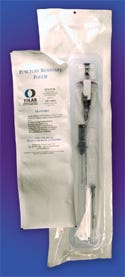September 2, 2007
Originally Published MPMN September 2007
BREAKTHROUGHS
Pouch Provides Puncture-Resistant Packaging for Trays
|
Puncture-resistant pouches from Tolas feature a clean, fiber-free peel after sterilization. |
Packing a tray in a durable pouch is an alternative packaging method to traditional tray and lid assemblies for medical device manufacturers. If not properly constructed, tray and lid assemblies can lead to problems like lid tearing. Tolas Healthcare Packaging, an Oracle Packaging co., had customer requests for an alternative to traditional tray packages—and for a stronger, sterilizable packaging film. “It was two years before we felt we had a product that would outperform materials previously available in the industry,” says Denise DiLissio, marketing team leader at Tolas. The company now offers a pouch specifically designed to meet requests for a flexible film strong enough to package procedural kit trays or angular-shaped medical devices without any potential for tearing.
“It has been an issue in the industry that the standard polyester/polyethylene films used in some Tyvek and film pouches were not puncture resistant enough for all applications,” says DiLissio. “Applications such as implants that are first packaged in a tray and lid and then inserted into a pouch were failing due to these films.” DiLissio describes such failures as tears in the pouch film caused by the corners or edges of the inserted trays or devices.
The company set out not just to make a stronger film, but to make a stronger film that was also very flexible and provided high clarity and sealing capabilities. And because the pouch packaging is for medical devices, it also needed to be sterilizable. “Our biggest challenge was identifying a film that could successfully contain tray packages and devices without puncturing while also providing a uniform peel for sterile presentation of the device and a visible seal transfer for assurance of seal integrity,” DiLissio says.
Tolas tested several of its Seal Science brand adhesives to determine which would provide the best possible uniform seal and seal transfer when peeled open. Ultimately, the company chose its TPT-0270 heat-seal-coated Tyvek. This material produces a clean, fiber-free peel after sterilization to prevent airborne particulates from contaminating the enclosed device. In addition to Tyvek, the pouch features a 4-mm nylon lamination to increase the pouch’s durability and abrasion resistance. The pouch seal is also designed to provide positive indication of seal integrity. It is in the form of a solid white adhesive transfer visible upon opening without any potential contamination to the contents from the seal or seal residue.
The pouch film is designed to provide high barrier protection to prevent microbial contamination under the most rigorous conditions of high stress during handling or transporting. It can be sterilized using EtO and radiation methods.
“It is the overall thickness and the layer of nylon in the film that provide the puncture and abrasion resistance desired by the industry and our customers,” says DiLissio.
Tolas tested the material for puncture resistance in accordance with the ASTM F1306 test method, the Standard Test Method for Slow Rate Penetration Resistance for Flexible Barrier Films and Laminates. The company also conducted the standard compliance testing required to provide ISO 11607 information and data.
Tolas continues to offer design recommendations for correcting existing tray packages on its Web site. A technical information report on minimizing tearing of peelable heat-seal lidding and design configurations covering lid placement, tray flange shape, and different types of lid tabs for distributing peel force are also available.
Tolas Healthcare Packaging, an Oracle Packaging co., Feasterville, PA
www.tolas.com
Copyright ©2007 Medical Product Manufacturing News
You May Also Like



.png?width=300&auto=webp&quality=80&disable=upscale)